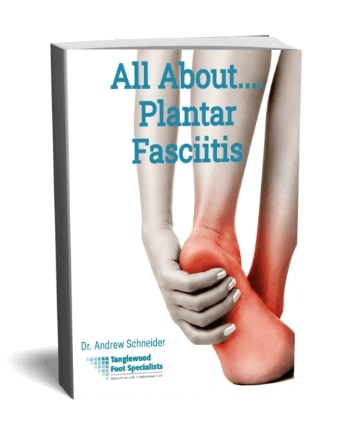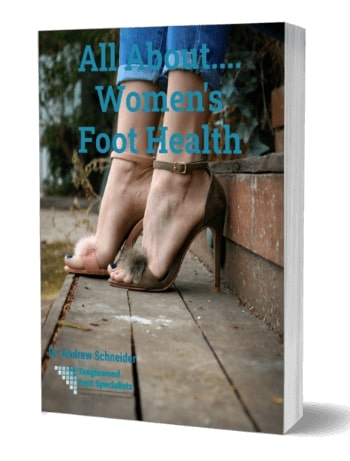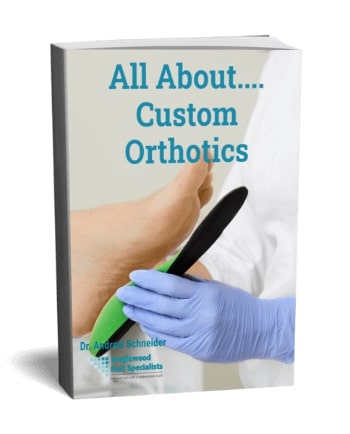Maybe you’ve suffered with plantar fasciitis. Perhaps you still are. Some of you may have never heard of plantar fasciitis. One thing I can tell you is that once you hear about plantar fasciitis, it seems like EVERYONE has had it at some point.
Here’s the thing, while plantar fasciitis is a common cause of heel pain, it is not the only cause. I’d like to share with you some other issues that also can be responsible for heel pain. If any of these seem familiar, don't wait! Contact the office for an immediate appointment.
 Plantar fasciitis causes pain on the bottom of the heel. An inflamed Achilles tendon will often cause pain on the back of the heel. The Achilles tendon is one of the most used and strongest tendons in your body. It also, has some weak points, largely because of a section with poor blood flow. That can lead to the tendon becoming inflamed. And once the tendon is inflamed, it is a tough condition to treat.
Plantar fasciitis causes pain on the bottom of the heel. An inflamed Achilles tendon will often cause pain on the back of the heel. The Achilles tendon is one of the most used and strongest tendons in your body. It also, has some weak points, largely because of a section with poor blood flow. That can lead to the tendon becoming inflamed. And once the tendon is inflamed, it is a tough condition to treat.
Treatment for Achilles tendonitis is almost always conservative. This includes anti-inflammatory medication, heel lifts, and medical-grade insoles. Custom orthotics often take care of the problem long term. A word of warning, it may take longer than you expect for the pain to resolve.
-
Tarsal Tunnel Syndrome
Most of you have heard of carpal tunnel syndrome. That is a nerve impingement in the wrist that causes symptoms in the hand. Well, you have a similar structure on the inside of your ankle called the Tarsal Tunnel. The nerve that travels through the tarsal tunnel can also become impinged. This can lead to many symptoms, including heel pain. In fact, the heel pain can mimic plantar fasciitis.
Treatment for Tarsal Tunnel Syndrome involves anti-inflammatory medication or cortisone injections. Insoles or custom orthotics are helpful, as they take the pressure off of the nerve. In some cases, surgery may be necessary to relieve the pressure within the tarsal tunnel.
 Here’s one for the kids! Sever’s disease is a syndrome that affects kids ages 7-14. First of all, it is not a disease. It is a syndrome where the Achilles tendon pulls on the growth plate at the back of the heel. This causes the growth plate to become inflamed. Kids are often told that they’ll grow out of the pain. Technically, the pain should stop once the growth plate fuses. I wouldn’t want my child to be in pain for that long. I’m sure you don’t either.
Here’s one for the kids! Sever’s disease is a syndrome that affects kids ages 7-14. First of all, it is not a disease. It is a syndrome where the Achilles tendon pulls on the growth plate at the back of the heel. This causes the growth plate to become inflamed. Kids are often told that they’ll grow out of the pain. Technically, the pain should stop once the growth plate fuses. I wouldn’t want my child to be in pain for that long. I’m sure you don’t either.
There are ways to treat this inflammation and pain. No one wants your kids’ feet to hurt. Least of all me! We’ll start with stretching and using a night splint. We also use anti-inflammatory medication and medical-grade insoles to support the foot. That’s usually enough to keep your child active without pain.
 Heel spurs are sometimes associated with plantar fasciitis. They are two different conditions. Not every case of plantar fasciitis involves a heel spur and vice versa. A heel spur is a growth of bone on the bottom or back of the heel bone. The spur that forms beneath the heel usually is not the cause of pain. This is because the spur is well cushioned with a layer of fat padding. If that fat pad wears away, however, it can be painful.
Heel spurs are sometimes associated with plantar fasciitis. They are two different conditions. Not every case of plantar fasciitis involves a heel spur and vice versa. A heel spur is a growth of bone on the bottom or back of the heel bone. The spur that forms beneath the heel usually is not the cause of pain. This is because the spur is well cushioned with a layer of fat padding. If that fat pad wears away, however, it can be painful.
A heel spur on the back of the heel is also usually not painful. It can cause a condition called a Haglund’s deformity. This is a bump on the back of the heel that gets irritated when the back of your shoes rubs on it. I can often control this pain completely. Sometimes, surgery is necessary to remove the bone spur.
A stress fracture is a hairline fracture that occurs in the heel bone. It is the least common of these conditions, but one that’s important to treat. When the heel bone gets overloaded with repetitive stress, the bone can break down and crack. Unlike a complete break, there’s usually not a high level of pain, swelling, and bruising. The pain actually can mimic plantar fasciitis. This is why taking a simple x-ray is so important.
Treatment for a stress fracture involves immobilization in a fracture boot. You can expect to be wearing one for six to eight weeks. The bone will heal to full strength and you’ll be able to resume your previous activity. You have to be patient with it as your heel heals.
No matter what is causing your heel pain, relief is a phone call away. Contact the office if you’ve been suffering with heel pain. I’ll help you figure out the cause and get you on the road to recovery.






















